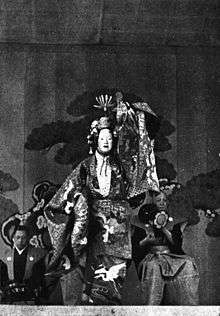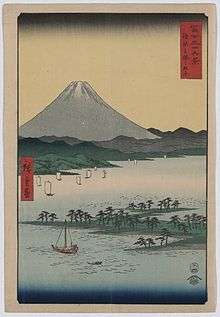Hagoromo (play)
| Hagoromo | |
|---|---|
| 羽衣 | |
| English title | The Feather Mantle |
| Category | 3rd — katsura mono |
| Characters |
shite angel waki Hakuryō, a fisherman wakizure companion(s) |
| Place | Pine Grove of Miho, Suruga Bay |
| Time | spring, at night |
| Sources |
Tango fudoki (8th century) Nōin (11th century) |
| Schools | all |

Hagoromo (羽衣 The Feather Mantle) is among the most-performed Japanese Noh plays.[1][2] It is an example of the traditional swan maiden motif.[3]
Sources and history
The earliest recorded version of the legend dates to the eighth century.[3] The play however apparently combines two legends, one concerning the origins of the Suruga Dance (Suruga-mai) and another the descent of an angel onto Udo Beach. A parallel story may also be found in the 14th volume of the fifth-century Sou-shen chi. A poem by the 11th century poet Nōin is quoted.
The authorship of the Noh play Hagoromo is unknown.[2] The earliest references to the play in historical records date to 1524, which suggests that it was written well after Zeami's time.[2]
Plot

A fisherman is walking with his companions at night when he finds the Hagoromo, the magical feather-mantle of a tennin (an aerial spirit or celestial dancer) hanging on a bough. The tennin sees him taking it and demands its return—she cannot return to Heaven without it. The fisherman argues with her, and finally promises to return it, if she will show him her dance or part of it. She accepts his offer. The Chorus explains the dance as symbolic of the daily changes of the moon. The words about "three, five, and fifteen" refer to the number of nights in the moon's changes. In the finale, the tennin disappears like a mountain slowly hidden in mist.[4]
Later adaptations
W. B. Yeats' At the Hawk's Well drew extensively from the Hagoromo legend.[5] Osamu Tezuka based a short story in his Phoenix series on the story of the Hagoromo, but with a sci-fi twist, featuring a time displaced human girl from the distant future instead of a tennin. Recently, the story was adapted into the manga and anime series Ceres, The Celestial Legend.[6]
See also
References
- ↑ Kinoshita, June & Nicholas Palevsky. Gateway to Japan. Kodansha International (1998), p121. ISBN 4-7700-2018-X.
- 1 2 3 Tyler, Royall. Japanese No Dramas. Penguin Classics (1992), p96. ISBN 0-14-044539-0.
- 1 2 Blacker, Carmen. Collected Writings of Carmen Blacker. Routledge (2000), p44. ISBN 1-873410-92-1.
- ↑ Pound, Ezra. "Noh", Or, Accomplishment: A Study of the Classical Stage of Japan. Macmillan (1916), p165. This article incorporates text from this source, which is in the public domain.
- ↑ Murphy, Maureen. "Some Western Productions of At the Hawk's Well, with a Mythological Footnote." In Tumult of Images: Essays on W.B. Yeats and Politics (ed. Peter Liebregts and Peter van de Kamp). Rodopi (1995), p71. ISBN 90-5183-771-2.
- ↑ Drazen, Patrick. Anime Explosion!: The What? Why? & Wow! of Japanese Animation. Stone Bridge Press (2003), p41. ISBN 1-880656-72-8.
External links
- English translation of the Hagoromo Noh play by Arthur Waley
- English translation of the Hagoromo Noh play by Ezra Pound
- Hagoromo Noh play Photo Story and Story Paper